Benin
Things to Do
Porto Novo
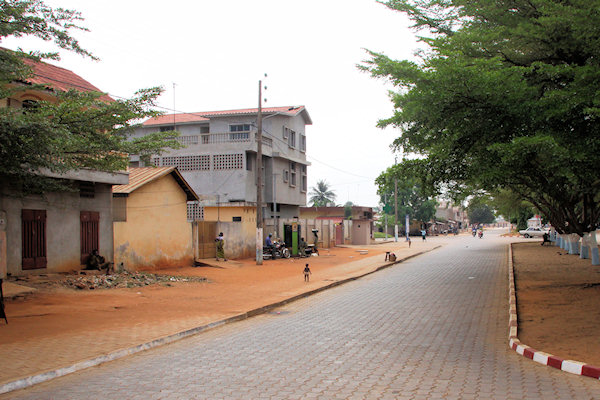 |
|||||
Nestling on the shores of Lake Nokoué, Porto Novo is Benin's unlikely capital.The city
has somehow escaped the manic nature of its neighbours (Cotonou/Lagos) and carries on instead at a mellow,
unperturbed pace.
Its leafy streets, wonderful colonial achitecture and interesting museums mak it a fabulous escape from
full-on Cotonou.
Porto Novo has been Benin's official capital since it was used as such by the French, whose colonisation
followed the Wars of Resistance that began here in 1890.
The portuguese named the city after Porto where they established a slave-trading post here in the
16th century.
Musée Ethnographique de Porto Novo
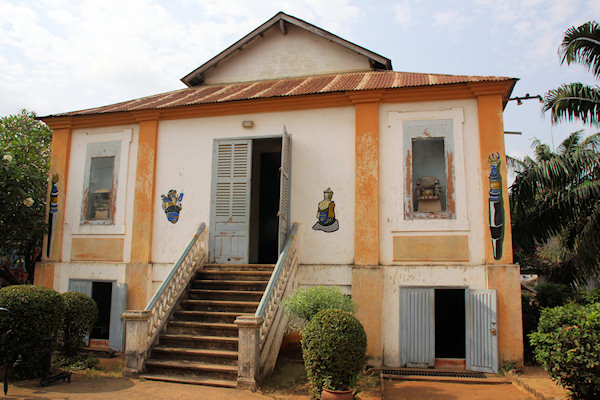 |
|||||
The "Alexandre Sènou Adandé" Ethnographic Museum in Porto-Novo was created in 1957.
Alexandre Sènou Adandé is a skilled African ethnologist, Benin politician and international public
servant who worked very hard to ensure that the museum would open to safeguard Benin¹s cultural heritage.
The building that houses its collections was actually built around 1922 as a residence for the Principal
of the Porto-Novo Central City School. It later became an orphanage. Subsequently, senior colonial officers
were lodged in the building and for a period it also served as offices for the Ministry of Education.
The colonial building was designed in an Afro-Brazilian style and was constructed on concrete pilings.
Later, the spaces between the outside pilings were filled in and the style of the building became very
classical with a ground floor and first floor.
The museum opens with a big map featuring the main tribal groups of Benin.
The top floor is organised thematically around birth, life and death, with everything from costumes to
carved drums.
Downstairs is an impressive display of the Yoruba's inventive Gelede ceremonial masks, some
dating back 200 years.
Porto Novo - Herbal Market
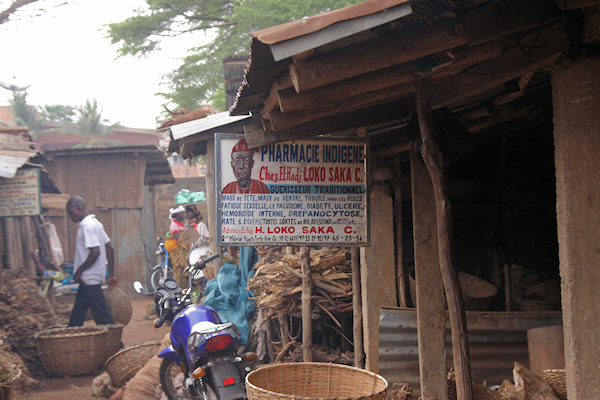 |
|||||
Traditional herbal medicine has been practiced in Africa since prehistoric times.
Collecting herbs in Africa used to be the responsibility of African herbalists & spiritual leaders.
There were rules, taboos & traditions governing how & what herbs in Africa were collected and what
they were used for.
Present day African herbalists are highly trained and are accorded the same kind of respect given to
trained doctors in the developed world. African herbalists continue to be the spiritual, political &
scientific leaders of their communities.
The large traditional herbal market in Porto Novo is worth visiting.
Cotonou
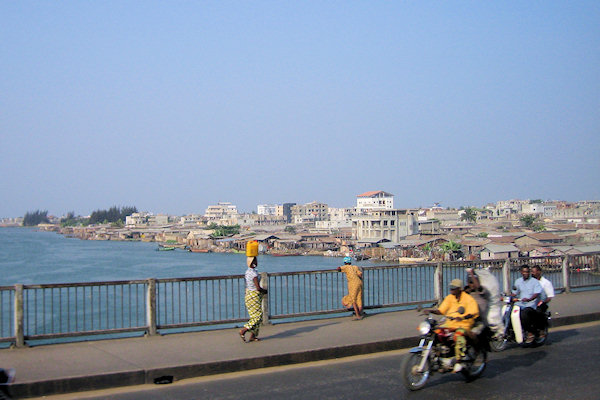 |
|||||
Founded in 1830 by King Ghézo, after a request by Don Francisco de Souza, the slave trader
of Viceroy of Ouida infamy, for a new slaving port, Cotonou grew quickly from its small village
status to become a substantial town thanks to the, albeit dying, slave trade. this was later replaced by
the palm-oil and cotton trades.
The young city was given a further boost when the french took over the reins of power in 1864 and began
building the infrastructure of a modern city. However, it wasn't until the opening of the country's first,
and only, deepwater port in 1908 that Cotonou really blossomed and grew.
The city continues to grow at an alarming rate - there are hudge residential neighbourhoods to the west of
the airport standing on grounds that less than a decade ago was grassland and the city has the whole
spectrum of poblems: pollution, overcrowding, lack of jobs and housing, decaying and insufficient
infrastructure, growing crime levels, and an ever-increasing gab between the rich and poor, and the general
feeling of being unable to cope that characterises so many cities in the developing world.
Yet somehow Cotonou is holding it all together where so many of its African cousins have slipped into
the abyss; and this opportunity to see urban Africa getting by with little outside help is enough to make
it worth a visit.
Ganvié
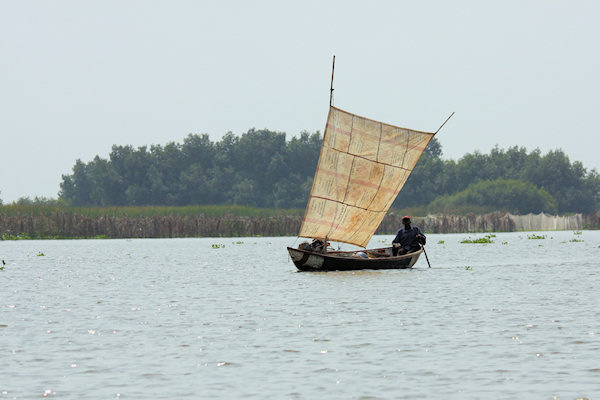 |
|||||
Stilt villages were built in Lake Nokwe, 20km north of Cotonou by the Tofinu people who fled there
to escape enslavement by the Kings of Dahomey.This was because of a religious ruling that meant that the
Dahomians would go anywhere but over water in their pursuit of human slaves.
Ganvié, the most famous, is a very large village made up of bamboo houses resting on teak stilts,
perched above the water.
The village is scattered and all journeys between houses are done in wooden boats on the waterways that
separate them. When you are there, however, it is not only the ingenuity of the constructions that you
admire – your attention is also drawn to the details of village life like the colourful floating market
and the boats of chattering children heading off to school.
The welcoming Tofinu are primarily fishermen, which they do by planting branches on the muddy lagoon
bottom. When the leaves on the branches begin to decompose, the fish congregate there to feed. The people
like to show off their fishing skills as well as the ovens, situated next to their homes, where the fish
are dried. These smoked fish are taken and sold in the markets by the women.
The villagers also benefit by selling their fine wooden carvings to visitors.
Ouidah
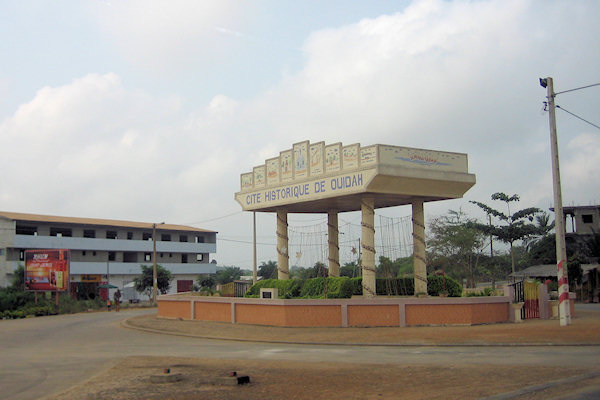 |
|||||
Ouidah is best known for its central role in the slave trade during the 17th , 18th , and 19th
centuries, during which time nearly 1,000,000 individuals were boarded onto ships from the beach at
Ouidah and were transported across the Atlantic.
Originally, however, Ouidah (once Gléwé) was a small village in the small Xwéda kingdom
that supported itself through agriculture, hunting and fishing in the coastal lagoons – the inhabitants
had very little to do with the sea and its treacherous tides.
Ouidah's first encounter with Europeans occurred during the 16th century. Though the slave trade along
the Bight of Benin began soon after, it was not until the end of the 17 th century that European traders
began purchasing slaves from the Xwéda kingdom in earnest, establishing factories and forts in the town of
Gléwé (now Ouidah). The kingdom of Xwéda prospered greatly from this trade, until in 1727 the militaristic
kingdom of Dahomey routed the kingdom of Xwéda , killing, capturing and dispersing its citizens, and
usurping trade with the Europeans.
In 1818 Dahomey installed Francisco Félix de Souza, known as Chacha by the Dahomeans, to manage
the slave trade on behalf of the kingdom of Dahomey . To this day, the descendants of de Souza hold a
place of importance in Ouidan society.
As European governments began to denounce the slave trade as brutal and unjustifiable, the trade in
slaves across the Atlantic all but closed. In the late 1800s the town of Ouidah began to focus its
export efforts on much less lucrative palm oil.
Basilica of the Immaculate Conception of Ouidah
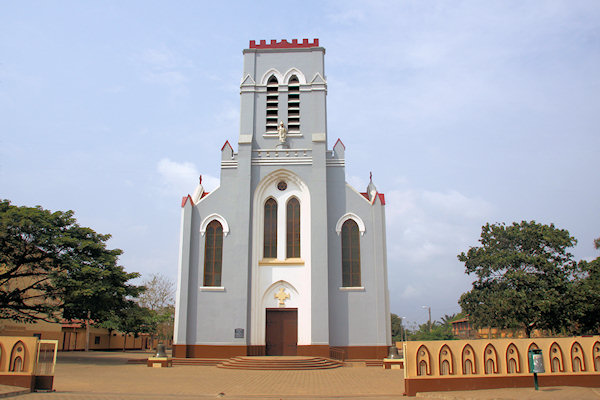 |
|||||
TheBasilica de la Conception Immaculée, situated right in the town centre, was originally built
as a cathedral, from 1903 at the instignation of Bishop Louis Dartois firts Vicar Apostolic of
Dahomey and was completed in 1909.
It has been elevated to minor basilica in 1989, during the visit of the late pope
It's a high, wooden-roofed affair and quite stark inside.
The tower, slightly down from the facade remains unfinished (an arrow was the crown, but was never
completed for lack of funds).
The Ouidah Museum of History
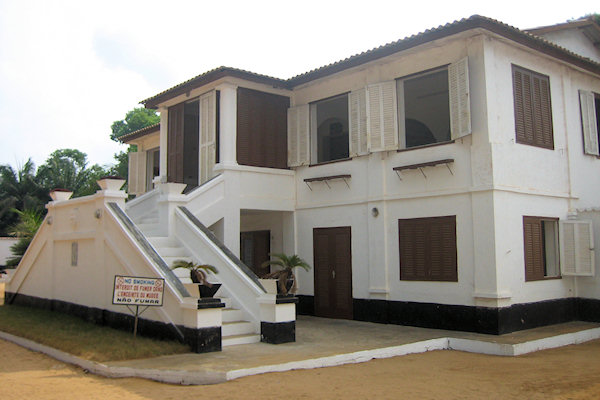 |
|||||
The Ouidah Museum of History is located within a compound that was once a Portuguese Fort, built
to facilitate the trade in slaves between the kingdom of Xwéda and Portugal. The fort was constructed in
1721 by Joseph de Torres, and remained the property of Portugal until 1961, when it was forcibly
annexed by the government of the Republic of Dahomey.
The fort itself is one of the finest treasures of the Ouidah Museum of History. Its outer walls form a
trapezoid, and the compound covers approximately one hectare in total. Originally, the fort was surrounded
by a deep, broad moat; persons entering the fort were required to cross a bridge which was removed each
night. Within the compound was a central building for sleeping and receiving guests, as well as an office,
a military garrison, a powder magazine, barracks, a chapel, and a holding area for slaves.
Throughout its life under Portuguese control, the fort allowed the Portuguese to maintain diplomatic and
trade relationships with the area's reigning power, and as social, religious, and trade needs changed, so
too did the fort. The compound was gradually de-militarized and made more suitable for comfortable living
and entertaining guests.
In 1861, the fort became the base of a Catholic Mission, which established the Kingdom of Dahomey 's first
school, and soon after began baptisms. When the French succeeded in colonizing Dahomey in the 1890s, the
fort was deemed exclusive property of Portugal.
Though the Portuguese burned the Fort and its contents when they were ejected by the newly independent
government of Dahomey in 1961, the Museum retains many antique objects recovered from the fort during its
reconstruction in the mid-1960s.
There are also numerous historic maps and illustrations dating from the Portuguese occupation of the fort.
Ouidah - Route des Esclaves
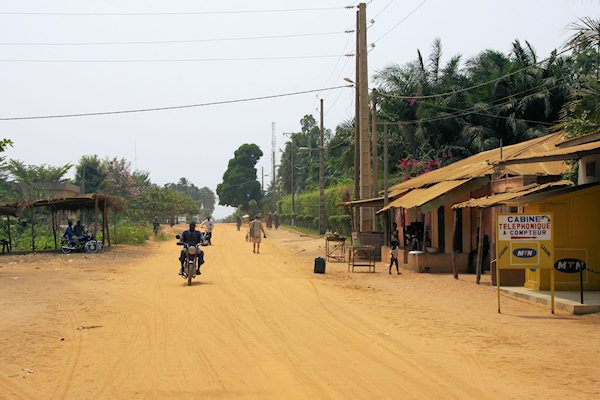 |
|||||
The 4 km road between the Ouidah Museum of History and the beach is probably the same road thousands
of slaves traveled on their way to board the slaving ships for the New World. Along the road are large
painted concrete statues depicting Vodun symbols.
Notable stops along the Slave Route include:
The Slave Auction, where various European powers selected and purchased slaves destined for resale
in the new world, was held at Place Chacha in front of the home of Francisco de Souza.
Slaves were branded according to the mark of the purchaser at the Tree of Forgetting. The name of
the place, however, stems from the ritual of turning slaves around the tree to reinforce forgetfulness of
their homes. Men were walked around the tree 9 times, and women 7 times.
The Zomaï Cabin was an obscure hut where the slaves were held prior to departure. The meaning of
zomaï is “where the light does not go”. The close quarters within the cabin habituated the slaves
to the conditions they would face on board the slave ships.
Also called the Wall of Lamentations, the Memorial of Remembrance is 6 meters tall, and the imagery
displayed on it tells the history of slavery in Benin. The wall was erected on the site of a mass grave
slaves who died before leaving Africa.
King Agadja of Dahomey planted the Tree of Return in the grand Place de Zoungbodji,
marking the point of last goodbyes. By turning three times around the tree, slaves could ensure that their
spirits would return to their homeland after death. Zougnbodji was the first customs point where the
movement of slaves was controlled, and the last point where the slaves saw the soils of Africa.
From the Ouidah beach, the slaves were loaded onto longboats and taken to large slaving vessels. On the
beach today there is a remarkable monument to the slave trade erected by UNESCO known as the Point of
No Return.
Ouidah - The Temple of the Python
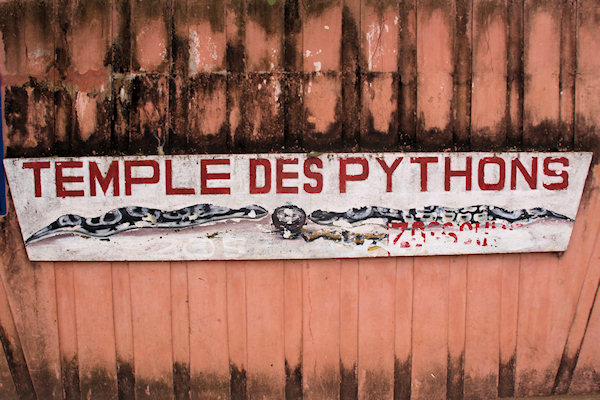 |
|||||
As in many African and Asian cultures, snakes are an object of veneration as well as fear. In Voodoo
the snakes represents the god Da,Dan or Dangbe, who is the bringer of life and fertility and the
favourite god of Ouida. Rainbows are another symbol of Da and all over the temple you will see pictures
of bright rainbows alongside snakes.
Though it's all a bit of a tourist trap these days it's still a religious site and the snakes are used in
the Voodoo ceremonies held here, none of which you are likely to see.
What you will see however is a room full of lazy snakes, several of which may well be draped over you for
a photo session.
You will be given a brief tour of the rest of the templ and an explanation of everything that takes
place within its walls.
Ouidah - Voodoo Day
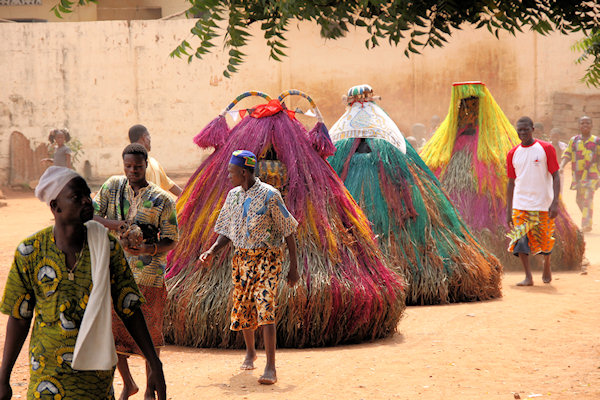 |
|||||
Voodoo, or
The practice conforms to the general pattern of West African religion, with a supreme god, Mawu, and
a host of lesser spirits that are ethnically specific to their followers and to the part of the spiritual
world inhabited by a person's ancestors. Traditional priests are consulte for their power to
communicate with particular spirits and seek intercession with them. this communication is achieved
through spirit possesions and ritual that often involves a gift or "sacrifice" of palm wine, chikens
or goats. The grace of the spirits is essential for protection and prosperity, and some spirits can be
harnessed for malicious and selfish ends.
Voodoo was formally recognised as a religion by the gouvernement in februari 1996. since then, 10 januari,
Voodoo day, has been a bank holiday, with celebrations all over the country. Those in Ouidah,
voodoo's historic centre, are amongst the best and most colourful, with endless singing, dancing, beating
of drums and drinking.
Grand-Popo
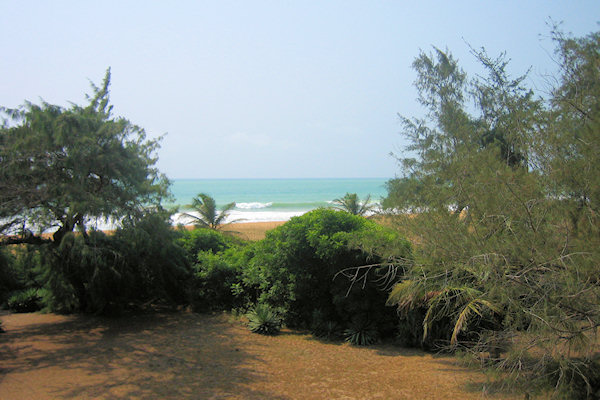 |
|||||
Don't look here for a idyllic tropical beach holiday, but when you're just after a place to kick back for
a day or so after tackling inland Benin Grand-Popo fits the bill perfectly.
It's also an extremely chilled-out and friendly little place where you can treat any conversation with
a stranger as nothing more than just a curious chat rather than the build-up to the sales pitch that seems
to be standard of beach resorts in so many other countries.
The town was once one of the most important centres of trade with Eoropeans along the coast, reaching its
financial pinnacle during the people trade. For a short time the town boomed, but with the abolition of
the slave trade and the construction of a big port in Cotonou towards the end of the 19th century
Grand-Popo started to fade away.
Today there is almost nothing at all left to see; however if you want to get your bum out of the hammock
then there are a few walks you can do in the area and a bit of piroque paddling down the Mono River.